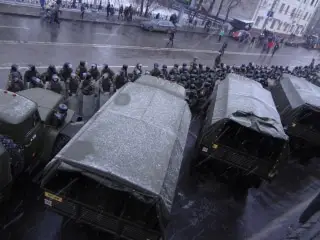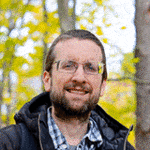
This is me standing with a white ribbon and carnation, a symbol of the peaceful protests held that day. The orange flag to my right is for the Solidarity movement – a formerly minor political movement that organized the protests.
Moscow is very cold in the winter. There isn’t a lot that would motivate a large crowd of people to stand outside in the freezing snow and rain for 5 hours, yet on December 10, 2011, I, along with 50,000 Russians, did just that in protest of the recent elections. I was amazed that such an event was taking place, and even more amazed that I, an American studying abroad in Saint Petersburg, was lucky enough to witness it.
My friends and I had planned our trip to Moscow weeks earlier. We were all really excited to visit the city for the first time and see the popular sights, such as Red Square, the Kremlin, and especially Lenin’s Mausoleum. As the date of our trip approached, so did the date of Russia’s parliamentary elections. If you didn’t know about the elections, nothing in Saint Petersburg would have told you they were happening. Elections in Russia are not given anywhere near the same attention as elections in the US. Unsurprisingly, the elections resulted in a comfortable, but not overwhelming, win for Putin’s party. What was surprising, however, was the public reaction.
In the following days, I watched as the international media judged the election as fraudulent. This was nothing new for Russia, but soon I heard of people mobilizing in protest around Saint Petersburg. I also heard that they were being met by large groups of police, and I debated on going. I knew that Russia, in general, does not look kindly on protests, and that police officers do not operate within the same standards as US police. In the US, policemen pepper spraying protesters became news of police brutality, yet much worse is common in Russia.
A friend in Moscow informed me that when I came to visit that weekend, a very large protest was going to take place. He told me that over 40,000 people had committed to attend on various social networking sites. This was going to be the largest protest in Russia since the fall of communism, and I knew I had to witness this historic event. I was thrilled that I had already booked my ticket for that weekend.

Many of friends in St. Petersburg were concerned when I said I would go. However, the police presence was actually quite friendly.
I informed my friends who were traveling to Moscow with me that I was planning on attending the protest, and they were concerned. They understood how important the event was, but were rightfully worried about their safety and mine. I respected their decisions not to go, but told them I was going anyway.
When I met my friend in Moscow, he was just as excited for the protest as I was. He is currently working for The Moscow Times, and was excited to report on the event. He also planned on bringing a folder with documents just in case things got out of hand. He had proof that he was a journalist, a list of his rights, and contact information for the newspaper’s lawyers. He was ready.
On Saturday morning, the day of the protest, I was determined to see Lenin’s Mausoleum. As we arrived at Red Square, a policeman approached us and told us that the square was closed today (we assumed because of the planned protests), but that Lenin was accessible from a different entrance. As we left the mausoleum, we noted how quiet the usually busteling center of Moscow was. The ice rink in the center was missing its normal flow of children and their parents, and St. Basil’s Cathedral had only a few tourists in front of it. As we left the square, a band of about 50 riot policemen passed us. They all had huge helmets, protective vests and batons at the ready. We left the square and saw even more policemen and police vehicles blocking the square. Even the McDonald’s right outside the Kremlin was blocked.
Finding the protests, however, was easy. Hovering helicopters pointed the way to the growing crowds that we could hear before we could see. Thousands of people were filling the park, and even more were lining the other side of the canal. There were metal detectors at the entrance of one side of the park, but on the side my friend and I came in, there was only a row of intimidating tanks. We spotted a woman handing out bright white ribbons that symbolize the protesters’ frustration. I proudly fastened one to my coat.

Official news reports in Russia stated that 25,000 people attended the event. However, anyone that was there can attest that the numbers were far greater than this.
When we walked in, my friend remarked that he felt like we were riding the metro during rush hour because there were so many people packed in a small space. Many people had creative signs calling for a reelection, and others boldly held signs specifically calling for the end of Putin’s control in Russia. Usually, people carrying bolder signs were older, but what amazed me was that whenever you wanted to take a picture of the sign, they would proudly stand next to their views and pose for pictures. They weren’t afraid of anything.
At the protest itself, there really wasn’t much to be afraid of. I have never seen so many police officers in my life, and although their helmets, batons and shields were intimidating, they mostly just stood around. My Russian is by no means perfect, and a lot of the time I could only understand the basic chants. At one point, my friend and I were squished in the exact center of the protest as we heard people shout, “Russia without Putin!” over and over. I had not expected to hear such a bold statement and it alarmed me. It occurred to me that such a claim denouncing the Prime Minister could be reason for the waiting riot police to intervene, so I grabbed my friend and we made our way to the outside. However, the police never intervened and, as far I saw, only a handful of them ever even entered the park.
My friend and I were there for a few hours, and it was freezing; everyone was really bundled up, including myself. Many people began to leave as the snow turned to icy rain, and passing protester passed my friend and I two big white flowers. With our white flowers and white ribbons, the two of us looked the part of peaceful protesters. People began to take pictures of us, and we couldn’t understand why, until one man came up to us and thanked us for being so young and so aware of what was going on in Russian politics. My friend and I both look young to begin with, and since we were bundled up with huge white flowers, we probably looked like a pair of teenagers. I haven’t found our pictures on any websites yet, but I will keep looking!

Most at this event were technologically savvy – such as this woman taking a picture with her iPad. The sign in background says: “Путин, хватит чуровать” (Putin – enough Churov-ing). “Чуровать” is a made-up verb derived from the name of head of the Central Elections Commision, Vladimir Churov, who many people believe Putin used to make sure that United Russia won its majority. It derives part of its humor from its similarity to the Russian “шуровать,” which means “to stoke a fire.”
As we left the protest, policemen lined the streets. I could not believe how many policemen (and some police women!) there were. They were standing only inches apart from each other all the way from the protest to the Kremlin. It was impressive. The distance was about a mile and half, and I knew there were many more that we did not see.
As I was walking back over the bridge that led to the protest, I noticed about 20 army-like vans parked underneath. Standing next to the vans were around a hundred Interior Ministry Troops decked out in full riot gear. It was an interesting sight to see, and I just stood there looking over the bridge for a few minutes. One of the policemen noticed that I was staring, and started to wave. I couldn’t believe it. I didn’t think that the policemen would be willing to break their intimidating personas so easily, and I didn’tknow what to do. I told my friend, and he waved back. The wave was returned with about five other soldiers excitedly waving back at us. I can honestly say that I never thought I would be cheerfully waving to someone dressed as threateningly as they were, yet there I was. I wonder what they thought of the protests, if they secretly supported the cause despite their role in it.
I am so proud to have witnessed such an amazing event. When I got home I fastened the white ribbon to the outside of my purse and proudly showed my Russian language teacher. She told me that she agreed with what the ribbon said and was excited that I went. I am not sure exactly what will amount of the protests, but I am thrilled that I was able to be a part of it and cannot wait to watch what else happens.



